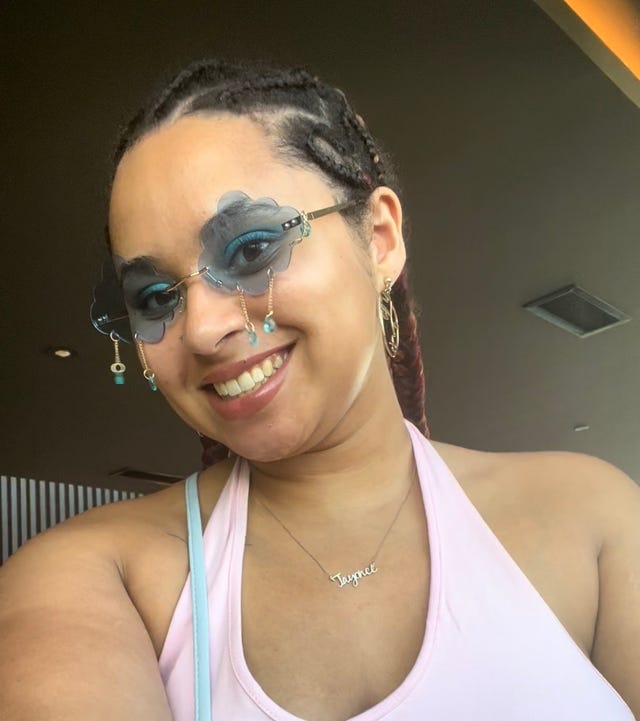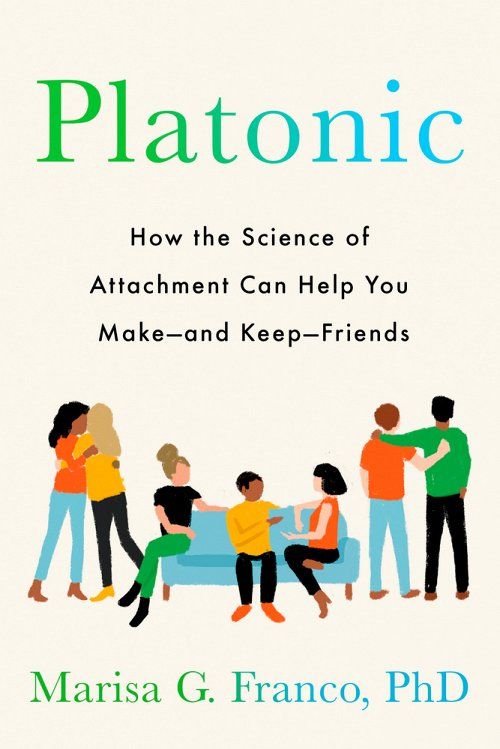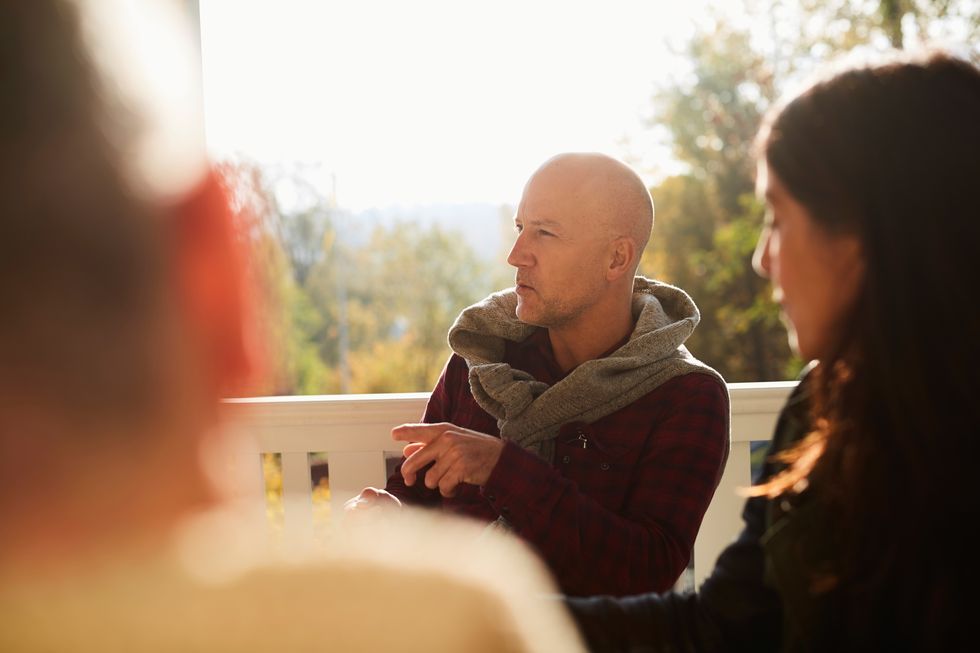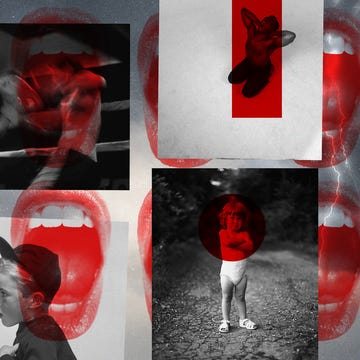Friendships are love stories too. In the Shondaland series The Art of Friendship, we explore and appreciate the beauty and complexities of friendship, as well as what makes it so powerful. From expert tips on how to navigate conflicts and deepen your friendships to uplifting stories of reconnections and advice on making new friends, these stories are reminders of the joy, value, and meaning that companionship brings to our lives.
Taylor Lamb is friends with five women who have known one another for the better part of the last seven years. Following their college years at the University of Virginia, the group became more intentional about maintaining their bond when proximity no longer bound them together. They revved up a group chat, held virtual hangouts around the holidays, and committed to always celebrating birthdays in person — even if it meant jumping on a train or a plane.
After a few years, each of the women ended up in the mid-Atlantic region for work, medical school, or law school. While they were physically close again, they began experiencing splinters in their seven-year friendship for the first time when some members of the group started backing out of planned gatherings at the last minute.
“I feel like people were feeling unheard and wanting more support,” Lamb says of the rift. The 25-year-old community engagement associate recognized that navigating the pandemic made communication even more difficult. “It just seemed like we all just needed to get in a room and talk.”
Lamb reached out to each friend individually and gauged their willingness for a group conversation; they all agreed to have one. In early May, they gathered in person (with one friend tuning in virtually) to have an open discussion with Lamb as their facilitator. With conversational guidelines painted onto a poster as a North Star, the ground rules were set. The gentle reminders encouraged the women to release any spirit of defensiveness, refrain from interrupting others, assume best intent — but mind impact — pause and take a deep breath if needed, and partake in other helpful actions.
To start, Lamb acknowledged that conflict is hard, especially for those who did not grow up encouraged to talk about their feelings or were unable to do so in a safe space. “I feel like acknowledging that made people not want to be reactive,” she says. Her goal wasn’t to come with an agenda but to “hold the space” for her friends to feel like they could share their thoughts safely. She opened the floor by asking who wanted to speak first, and each individual shared how they were feeling.
“The conclusions we came to,” Lamb says, “were that people had expectations of what they needed to be cared for, but they never said those.” She adds that bell hooks’ All About Love inspired how she approaches her relationships. “Me personally being an abolitionist and wanting to build a new world, we have to be willing to talk about our issues. And expecting other people to know how we feel is not what love really is.”
Before the exchange concluded, they each took turns expressing what makes them feel cared for, sharing their love language and coming up with specific communication guidelines to use moving forward. It dawned on Lamb that these women didn’t only want to be in one another’s lives for the good times, but that they cared about and valued one another enough to stick it out through the hard ones too. “I feel really happy that we’re all committed to our friendship in this way,” she says. “I feel closer to them.”
There’s a glaring absence of dialogue today on how to work through conflict with friends. The popular belief that a friendship shouldn’t make you uncomfortable and that you should cut someone off at the first sign of tension or disappointment has seeped into the collective consciousness, but relationship experts agree: That’s not real friendship.
“We tend to put friendship in this box as this trivial, second-class relationship,” says Marisa G. Franco, a psychologist and author of Platonic: How the Science of Attachment Can Help You Make — and Keep — Friends. “In doing so, we say things like ‘Friendship should be good vibes only’ or ‘It should be all positive.’ Some of these narratives really don’t leave space for things to go wrong and for conflict to happen, so when it does, we think, ‘Oh, maybe this is a sign the friendship should end,’ rather than it just [being] part of intimacy.”
Conflict is not an automatic sign that a friendship will end; addressing it can be a signal that both parties are committed to the relationship. Many people talk themselves out of bringing up an issue because they don’t want to seem as if they’re the problem, but withholding discomfort can manifest itself in another way, whether through withdrawal or resentment. “Think of it as something that will help not hurt,” says female friendship coach and educator Danielle Bayard Jackson.
Why should you address conflict with friends?
Honing your ability to work through conflict in a long-term platonic relationship is no different than learning to do so in a committed romantic partnership. Many withhold their feelings out of the fear that they will be perceived as dramatic or difficult or that it will tear the friendship apart, but with a real friend, that’s not the case. A 2012 paper found that open, non-blaming conversations lead to deeper intimacy between people, as opposed to not having those conversations at all.
Psychoanalyst Virginia Goldner came up with a concept for the illusion of closeness without conflict: flaccid safety versus dynamic safety. Flaccid safety is the sense of stability within a relationship when we pretend that nothing is bothering us. Dynamic safety is a more robust, deeper level of intimacy that is achieved when there’s rupture and repair, or in Goldner’s words, a cycle of “risk-taking and resolution” or “separation and reunion.” There is trust in the knowledge that issues will less easily come between friends and authentic comfort in the shared history that you are willing to work through hard emotions together.
“That closeness that you want with the friend where you feel like you can be yourself and you can say anything that we all dreamily speak of — to achieve that, sometimes you have to go through the awkwardness of bringing up something that makes you feel uncomfortable,” says Jackson. “It gives her a chance to demonstrate: I love you. I care about you. I hear you. We might get into it. We might disagree. All those things. But once we work it out, I’m going to feel more connected to you than I did before. That is not possible without having a difficult moment.”
When the challenge arises, don’t run from the chance to deepen your bond. Here’s how to address conflict with a friend, whether you’re bringing up the issue or responding to your loved one’s concern.
How to Address Conflict
Examine the problem
Coping with conflict is the goal, but that doesn’t mean you have to confront your friend every single time they do something that bothers or annoys you. A helpful way to assess if it’s worth going to them about it is if it is a recurring issue or a situation that has continued to affect how you perceive your friend and how you show up in your friendship.
“Anger is a signal that there might be some conflict to address, because anger tends to be a signal that there’s an injustice that’s happening,” Franco says. While this is true, Franco notes that we can acknowledge our anger without it being the emotion that guides the conversation.
Assess the relationship
Your level of closeness to the person is a factor worth considering when deciding whether to bring up an issue with your friend. Franco suggests, “If it’s not a friend that you’re particularly close to or if it’s a newer friend and you already find yourself getting into conflict, ask yourself: Is this a sign that this is maybe not a good friendship for me?”
Franco adds, “Generally, I say that if it’s a friend you’ve had for a long time, and you have each other’s best interests at heart, it’s always worth it to address it.” Conflict isn’t automatically an indicator of incompatibility; it may simply be the sign of differing preferences that can be bridged with communication.
Define timing
As the saying goes — timing is everything. “Ask yourself, ‘If this goes wrong, do I really have the capacity to tolerate that?’ You will hopefully say yes to that question,” Franco says. Emotional regulation is key to an effective conversation, and we are better at regulating our emotions when we’ve slept well, exercised, meditated, and are in a physically good space in addition to our mental one.
While you shouldn’t continually use personal struggles as an excuse to keep putting off the discussion, it is important to consider if you have the immediate capacity for it. Carve out an entire afternoon — or day, if you need it — so that you aren’t rushing through your chat and have time to process any emotions you may feel afterward.
Provide a warning
When it comes to conflict resolution, don’t surprise your friend with the topic. If you’ve given yourself a chance to prepare for the conversation, you should also extend the same courtesy to your friend. “If their pet just died or they’re going through a breakup,” Franco says, “they might just not have the capacity to do conflict well.”
Consider if they are in a space where they can actually receive and process your feelings. If not, it’s likely that they will go into fight-or-flight mode, and the discussion could be doomed from the start. While it’s important to be thoughtful, don’t make assumptions about whether your friend is in a good or bad space. Trust in their ability to decide for themselves, and ask gently ahead of time.
“I like to text an introduction to the conflict,” Franco says. You don’t have to be specific, but you can let them know that you have something on your mind you want to work through together and ask if they’d be up for talking about it.
Lean into vulnerability
If you feel nervous about bringing your feelings up, that may be a signal that it’s worth sharing. You don’t have to wait until you’re feeling confident about it; use those authentic feelings as leverage.
Jackson encourages resolution-seekers to acknowledge their messy emotions rather than shy away from them. “A lot of us feel anxious or vulnerable bringing it up,” she says, “but it can actually work in our favor.” Start the conversation by being honest about your nerves. (Jackson provides a few scripts: “I’m hesitant to bring this up because the last thing I want is for it to be awkward” or “I’m nervous, but I want to be open with you, and I hope you’d do the same for me.”)
If a friend sees that you have been thoughtful and considerate, it may ease their nerves as well and expand their ability to receive your emotions. “Being that transparent about your internal dilemma sometimes works for you,” Jackson notes, “in bringing down their walls.”
Use inviting language
When it comes to conflict, how you start the conversation influences the mood, tone, and direction of the talk more than you know. Franco calls this framing, or using verbiage that welcomes your friend in rather than alienates them. She gives an example of a positive framing script: “Hey, our friendship is really important to me, so I want to make sure we talk through things so that they don’t get between us. I was wondering if we can talk about something that’s been on my mind.”
It’s a warm way to remind your friend — and yourself — that you’re on the same team, not opposing sides. “You’re telling them how to interpret this,” Franco says. “That this is an act of love and a sign of your investment in the friendship, so the framing line is really important.”
Speak to your reality, not theirs
Addressing conflict isn’t about right or wrong; it’s about coming to a sense of mutual understanding. When sharing your dilemma, keep the focus of your words on you and how you feel by using “I” statements. Start by expressing how it made you feel when your friend did what they did. Don’t blame them, project assumptions onto them, or attack their character or ability to be a friend overall.
Think of it as a moment to share how it made you feel. Remember: Feelings are information, not fact. You have every right to feel let down that a friend bailed on you at the last minute, for example, but it doesn’t mean that your friend plotted to let you down.
Ask about their experience
After sharing your hurt, put on your listening ears, and listen to where your friend was coming from. Franco recommends asking about what was going on for them at that time, and what might have gotten in the way for them. “What you’re trying to do in a larger way is to embrace something called mutuality, which means you’re considering their experience and your experience at the same time instead of only thinking about yourself or thinking about them.” Franco says true mutuality is not about right or wrong but about finding balance and understanding. You don’t need to kowtow to their reasoning, but you should hear them out.
How to Respond to Conflict
View it as an act of love
If you have been approached by a friend about how you’ve hurt them, remember that they care enough to bring it to you and are willing to be their vulnerable self with you, which is not easy for most people.
While it may be uncomfortable, it might be even more unpleasant to think what might happen if they didn’t come to you. There is a chance they may have withdrawn from the friendship and let you go entirely. “Remind yourself that this is an act of love that is there to heal us and bring us together,” Franco says, “and that this is your friend showing that they’re invested in you enough to want to work through this issue.”
Protect yourself from fight or flight
Whatever you do, do not take notes from dramatic TV show scenes where two best friends are shouting what they hate about each other from across the room and one person stomps out.
“When you’re in fight or flight, you’re not able to engage in mutuality. You’re only thinking about your reality,” Franco says. Do what you need to do to refrain from sending emotions into overdrive — even if that means you need to take a break during the actual conversation. “If you have the capacity to de-escalate, always do,” Franco says. “For me, I think about the idea of splitting into two selves. … I see the part of me that wants to escalate this, and I have this other part of me that is going to try to access my higher self for this conversation.”
If the dialogue grows heated, verbalize that you need a moment instead of shutting down. Franco provides another script: “Hey, that’s kind of hurtful. I hope that we can have this conversation in a way that we’re not going to be labeling each other or putting each other down. And maybe that means we take a moment here.”
Ask for time
In the heat of the moment, it’s hard to remember that we are real people and not characters we see on TV. The witty, speedy, perfectly curated dialogue on-screen is not always a reality. In fact, quippy back-and-forth dialogue can promote defensiveness and regrettable statements.
If your friend surprises you with their concern, you are allowed to ask for some time to process this new information. “No one wants to hear that what they’re doing is not good enough,” Jackson says.
To keep from providing a knee-jerk reaction or justifying your actions, take a pause, ask for a moment, and call back later, or even take a day or two. It will help your relationship in the long run and give you space to be receptive rather than reactive. “I think you’ll find it very liberating,” Jackson adds, “because the first thing you want to say is often not the route you end up really wanting to have taken.”
Depersonalize it
Whatever your friend might tell you, rather than spiraling out of control about how you may be a bad friend, succumbing to the imaginary conclusion that they hate you, or convincing yourself that may be too [insert negative adjective here], frame it as information instead.
“At the risk of oversimplifying this, I wonder how much we’d be able to salvage our friendships if we took a breath and said, ‘Okay. That’s not mean. This is data,’” Jackson says. If a friend conjures up the courage to tell you they don’t like how you spoke to them or that a joke hurt their feelings, remember that it is simply their preference. A certain word or action may trigger them, but it might not trigger you, and vice versa. It’s simply about respecting and honoring your friend’s request next time.
Listen to understand
Don’t be afraid to ask questions to fully understand where your friend is coming from. Whatever information you need, take this as an opportunity to learn more about your friend and your friendship. Before the conversation ends, let your friend know that you hear them. Confirm what has upset them, and verbalize that you care and understand where they’re coming from — no ifs, ands, or buts. If you would like to avoid hurting them in the future, express how you will go about it next time.
Mia Brabham is a staff writer at Shondaland. Follow her on Twitter at @hotmessmia.
Get Shondaland directly in your inbox: SUBSCRIBE TODAY





















